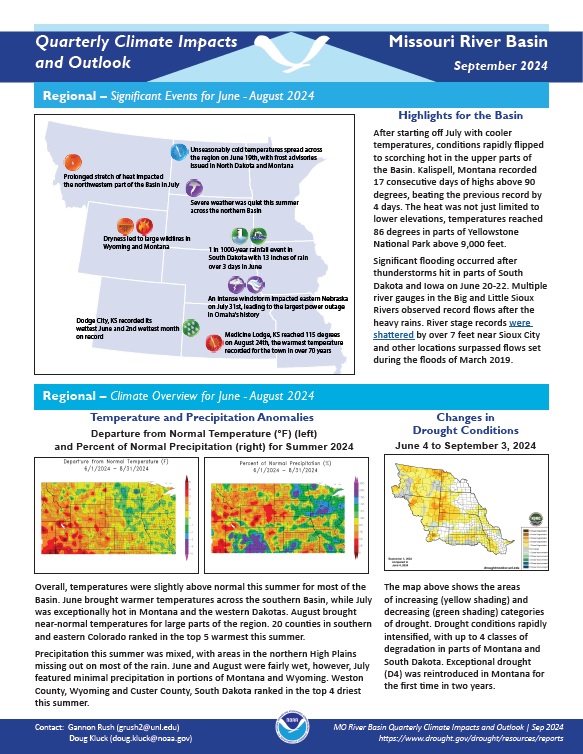Quarterly Climate Impacts and Outlook for the Western Region for June–August 2024. Dated September 2024.
Summer temperatures were above normal for most of the West except for isolated areas along the California, Oregon, and Washington coasts. California and Arizona saw their warmest summers on record with Nevada, Utah, and New Mexico having their second warmest on record. Precipitation was below normal for most of California, Nevada, Oregon, and Idaho.
Quarterly Climate Impacts and Outlook for the Missouri River Basin for June–August 2024. Dated September 2024.
Temperatures were slightly above normal this summer for most of the Basin. Precipitation this summer was mixed, with areas in the northern High Plains missing out on most of the rain.
Quarterly Climate Impacts and Outlook for the Southeast and Caribbean Region for June–August 2024. Dated September 2024. (Updated October 2024 to add Spanish translation of Caribbean information.)
Quarterly Climate Impacts and Outlook for the Mid-Atlantic Region for June–August 2024. Dated September 2024.
Average temperatures for the 2024 summer season were either 0–2°F or 2–4°F above normal across the Mid-Atlantic region. Precipitation amounts varied both across the region and over the course of the summer season. Some locations saw as little as 50%–75% of normal rainfall while others experienced over 150% of normal precipitation.
NOAA’s National Integrated Drought Information System (NIDIS) and Physical Sciences Laboratory are partnering with the California State Climatologist/California Department of Water Resources, NOAA’s National Weather Service (NWS) and National Centers for Environmental Information (NCEI), and the California-Nevada Adaptation Program, a NOAA CAP team, to deliver a user-oriented and evidence-based approach to drought early warning for sectors of our Nation’s economy susceptible to the hazards of too much and too little water.
Quarterly Climate Impacts and Outlook for the Mid-Atlantic Region for March–May 2024. Dated June 2024.
Average temperatures for the 2024 spring season were 2–4°F above normal for the majority of the region. Precipitation amounts varied across the region this spring, with some locations, particularly western Pennsylvania, experiencing greater than 150% of normal precipitation and a few areas receiving between 50% and 75% of normal spring precipitation.
Quarterly Climate Impacts and Outlook for the Southern Region for March–May 2024. Dated June 2024.
Spring temperatures were above normal for most of the Southern region and ranked third warmest out of 130 years of data. Precipitation was between 150% and 300% of normal across East Texas, Louisiana, Southern Arkansas, and isolated areas of Mississippi. Precipitation in South Texas, Far West Texas, and the Texas and Oklahoma Panhandles ranged from 5% to 70% of normal. The remainder of the region ranged from 70% to 130% of normal precipitation.
Quarterly Climate Impacts and Outlook for the Gulf Coast Region for March–May 2024. Dated June 2024.
Spring temperatures were well above normal across the Gulf Coast region with temperatures averaging 2°F to 4°F above normal in most locations. Precipitation was mixed across the Region during Spring.
Quarterly Climate Impacts and Outlook for the Southeast and Caribbean Region for March–May 2024. Dated June 2024. (Updated July 2024 to add Spanish translation of Caribbean information.)
Quarterly Climate Impacts and Outlook for the Western Region for March–May 2024. Dated June 2024.
Spring temperatures were generally near normal or below normal for most of the West. Precipitation was near-to-above normal for most of the West with north-central Arizona and southeast Montana much above normal.











